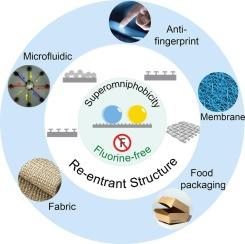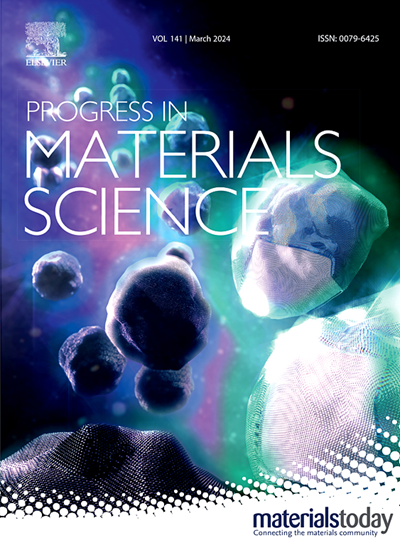非氟超疏水表面
IF 40
1区 材料科学
Q1 MATERIALS SCIENCE, MULTIDISCIPLINARY
引用次数: 0
摘要
超疏水表面,能够排斥各种液体,包括低表面张力的油,依赖于表面化学和质地之间的协同作用。几十年来,这些表面主要依赖于全氟烷基和多氟烷基物质(PFAS),因为它们具有优异的驱避性和耐久性。然而,PFAS在环境中的持续存在及其毒理学风险已促使全球法规逐步淘汰其使用。这种转变带来了巨大的挑战,特别是在纺织、食品包装和电子等部门,在这些部门,耐油和耐化学品是必不可少的,而无氟替代品仍然有限。虽然最近的研究在开发无pfas的超疏水表面方面取得了进展,但在理解和设计无氟超疏水系统方面仍有很大的差距。这篇综述提供了一个全面的概述,最近的策略,以实现超疏水性不含氟化学。我们讨论了基于纹理和化学的方法,包括用二氧化硅纳米颗粒、处理过的织物和金属氧化物纳米结构制成的涂层,以及利用先进的3d打印来制造双重和三重可重入几何形状的无涂层系统。重要的是,我们强调了可扩展性、耐用性和液体特定性能方面的局限性。通过确定关键的材料和结构设计考虑因素,本综述为当前的挑战和创造可持续、高性能、无pfas的超全憎表面提供了清晰的视角。本文章由计算机程序翻译,如有差异,请以英文原文为准。

Non-fluorinated superomniphobic surfaces
Superomniphobic surfaces, capable of repelling a wide range of liquids, including low-surface-tension oils, rely on a synergy between surface chemistry and texture. For decades, these surfaces have primarily relied on per- and polyfluoroalkyl substances (PFAS) due to their exceptional repellency and durability. However, the persistence of PFAS in the environment and their toxicological risks have triggered global regulations to phase out their use. This transition presents substantial challenges, especially in sectors such as textiles, food packaging, and electronics, where oil and chemical resistance are essential and fluorine-free alternatives remain limited. While recent research has made progress in developing PFAS-free superhydrophobic surfaces, there remains a significant gap in understanding and designing non-fluorinated superomniphobic systems. This review provides a comprehensive overview of recent strategies for achieving superomniphobicity without fluorinated chemistry. We discuss both texture- and chemistry-based approaches, including coatings made with silica nanoparticles, treated fabrics, and metal oxide nanostructures, as well as coating-free systems that leverage advanced 3D-printing to fabricate doubly and triply re-entrant geometries. Importantly, we highlight limitations in scalability, durability, and liquid-specific performance. By identifying key material and structural design considerations, this review offers a clear perspective on current challenges and emerging opportunities for creating sustainable, high-performance, PFAS-free superomniphobic surfaces.
求助全文
通过发布文献求助,成功后即可免费获取论文全文。
去求助
来源期刊

Progress in Materials Science
工程技术-材料科学:综合
CiteScore
59.60
自引率
0.80%
发文量
101
审稿时长
11.4 months
期刊介绍:
Progress in Materials Science is a journal that publishes authoritative and critical reviews of recent advances in the science of materials. The focus of the journal is on the fundamental aspects of materials science, particularly those concerning microstructure and nanostructure and their relationship to properties. Emphasis is also placed on the thermodynamics, kinetics, mechanisms, and modeling of processes within materials, as well as the understanding of material properties in engineering and other applications.
The journal welcomes reviews from authors who are active leaders in the field of materials science and have a strong scientific track record. Materials of interest include metallic, ceramic, polymeric, biological, medical, and composite materials in all forms.
Manuscripts submitted to Progress in Materials Science are generally longer than those found in other research journals. While the focus is on invited reviews, interested authors may submit a proposal for consideration. Non-invited manuscripts are required to be preceded by the submission of a proposal. Authors publishing in Progress in Materials Science have the option to publish their research via subscription or open access. Open access publication requires the author or research funder to meet a publication fee (APC).
Abstracting and indexing services for Progress in Materials Science include Current Contents, Science Citation Index Expanded, Materials Science Citation Index, Chemical Abstracts, Engineering Index, INSPEC, and Scopus.
 求助内容:
求助内容: 应助结果提醒方式:
应助结果提醒方式:


